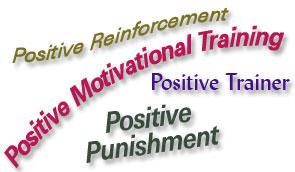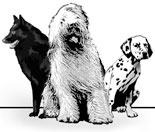
All you have to do is Google websites on dog training and they're there -- the marketing keywords: “Positive Methods,” “Positive Training,” “Positive Rewards,” “Positive Motivation.” Sounds great, right? Well… better take a closer look.
These catch-phrases are all the rage right now, so everyone is jumping on the bandwagon. Why? Dog training which uses positive reinforcement is (finally) becoming more popular. Dog magazines are talking about clicker training, there are more dog training organizations which are dedicated to ethical and humane treatment of animals, and websites and books abound on the topic. Folks are starting to realize that there is an alternative to the techniques used in force training, which utilizes choke chains and prong collars, along with alpha rolls and dominance downs, spray bottles with lemon juice, shaker cans with pennies in them, shock collars, electric fencing, mousetraps, the list goes on.
People, for the most part, love their dogs and WANT to be kind and gentle toward them. When they look up a trainer for some instruction, they may not be aware that there are different styles of training. They do what the instructor tells them to do; sometimes they follow instruction that includes force without question, and sometimes they stop themselves and think about what they are being asked to do with their dog. In the latter case, the owners may begin the search for another type of training which fits their belief system and/or conscience.
If these owners search websites and ads in phone books, they may find some of these “positive” catch phrases mentioned above. “Oooh, look!” they say to each other. “These trainers use positive methods in their training. Let’s go to them!” It’s very easy to become lured (no pun intended) by these terms, but it takes a bit more savvy to tease out what each trainer’s style REALLY is.
I suppose I can be hopeful that the use of the marketing ploy is a sign that the more “traditional” trainers are feeling the squeeze, and are trying to keep their businesses, because this would indicate that positive reinforcement training is overtaking the traditional methods in popularity. But it also indicates a certain dishonesty (or a definite lack of understanding) on the part of the trainer. Allow me to explain.
What, exactly, IS a “positive trainer”? In the strictest, most realistic sense of the word, a positive trainer is one who uses mostly positive reinforcement and a little bit of negative punishment, and no negative reinforcement and positive punishment. Confused already? Let’s define each term clearly:
Positive Reinforcement: Anything which follows a behavior which increases the chance that the behavior will happen again. So for example, when your dog does something you like, you immediately click and treat, throw a ball, play tug with the dog, give a butt scratch to the dog, or happily praise the dog so his tail wags. It is important to note that it is what THE DOG PERCEIVES AS BEING VALUABLE that makes something a reward.
Negative Punishment: The removal of the opportunity for the dog to earn things he likes, following a behavior we want to decrease. Examples: ignoring a dog who is barking at you for part of your dinner; putting the dog back in the house immediately if he bolts out the door and hits the end of his leash when you go to take him out for a walk.
Positive Punishment: The application of something that the dog perceives as aversive in response to a behavior we want to decrease. So for example, when the dog does something you don’t want him to do you the yank his prong collar, squirt water in his face, step on his paws, hit him, yell at him, give a disapproving look, or apply an electric shock. Keep in mind that it is what THE DOG PERCEIVES AS BEING AVERSIVE that defines positive punishment!
Negative Reinforcement: The removal of something that the dog perceives as aversive in response to a behavior we want to increase. Examples: the cessation of the pressure on a choke chain or prong collar in response to a pulling dog when the dog is back in the heel position; the cessation of the ear pinch technique when the dog opens his mouth and takes the dumbbell.
Now let’s take a look at what some trainers who call themselves “positive” are doing:
"XYZ SCHOOL" DOG TRAINING PHILOSOPHY
“XYZ Dog Training School" provides you with the guidance you need for the proper raising and care of your canine companion. We believe in teaching both you AND your dog. YOU WILL LEARN patience, praise, repetition, correction, and communication with your dog. Your DOG WILL LEARN obedience, right from wrong, and what is expected of him or her through the use of love, praise, and positive reinforcement.
 Looks great, right??? Look again. They use “correction.” Hmmm. What does that mean? It usually means that they use collar corrections…choke chains and prong collars. Is that positive reinforcement? No, it’s positive punishment and negative reinforcement. Here is an example of a photo from the same website.
Looks great, right??? Look again. They use “correction.” Hmmm. What does that mean? It usually means that they use collar corrections…choke chains and prong collars. Is that positive reinforcement? No, it’s positive punishment and negative reinforcement. Here is an example of a photo from the same website.
So, is this trainer a “positive trainer”? Where does the positive reinforcement come into play? Well, I’m sure the trainer uses some verbal praise in his or her training, but whether or not the dog perceives that as something pleasurable is unknown. What is certain, though, is that the use of a choke chain means that the trainer is also one who uses force-based techniques. My vote? Not positive at all. However, I at least give the trainer credit for SAYING that he or she uses correction; most don’t!
One major red flag on this person’s website is the complete lack of credentials. Nowhere on this site is it mentioned that the person has a background in behavioral science, attendance at seminars or conferences, or memberships of dog training organizations. Also lacking is the specific identification of training tools used. If this information is missing, go elsewhere. Let’s look at another site:
Owner C-------, a member of the Association for Pet Dog Trainers, has a diverse background training and working with dogs. Her work as a veterinary technician and manager of a holistic veterinary clinic deepened her interest in animal behavior. More than a decade of training workshops, professional pet care and dog ownership has only confirmed C----‘s belief that the most effective way to train a dog and manage behavior is to understand how dogs and humans interact and how to communicate clearly, positively and consistently.
 How does this one sound? Let’s see a photo from the same website:
How does this one sound? Let’s see a photo from the same website:
It’s clear from this photo that the dog is wearing a regular buckle collar. Her training approach includes the use of “reward-based training” and management and clear, positive and consistent communication. While we can’t be certain that this trainer is ONLY a positive trainer, her wording is consistent with one. A green flag of her website is that she clearly outlines where she got her training, lists the professional dog training organizations of which she is a member, and indicates that that she has continuously made efforts to further her learning.
In the end, the only way to really get an idea of what a trainer’s approach is like is to interview the person. Ask the tough questions, find out specifically what tools are being used, and ask permission to observe a class. If that request is denied, go elsewhere. There are plenty of dog trainers to go around, and dog training is not a regulated industry. It only takes moments to traumatize a dog; make sure that the trainer you select really IS a “positive trainer”!
Please read the AVSAB (American Veterinary Society of Animal Behavior) statement on dominance training.
http://www.avsabonline.org/avsabonline/images/stories/Position_Statements/dominance%20statement.pdf
-Also see: What to expect when a trainer says “We can train any dog.”
Click here to send your comments to the webmaster, your comments may be posted.
Comment in private to Ali
Return to the top of the page.
Learn more at the Training Hints Page.
Related pages on this site: About the Trainers / Our Approach / What is a Reward /
Door Manners
Myths of Positive Training



